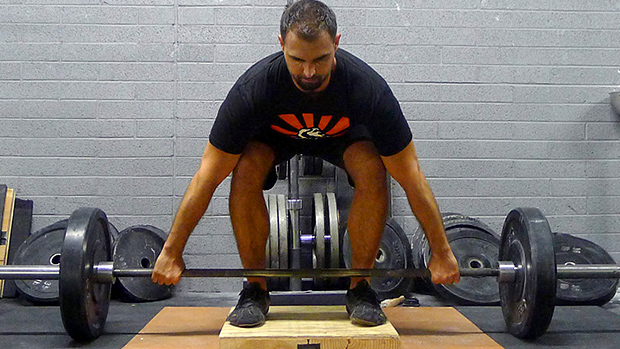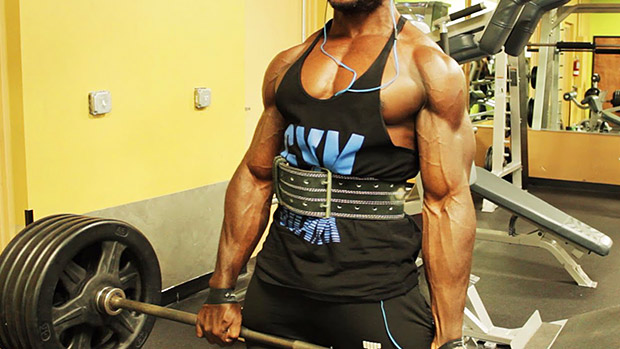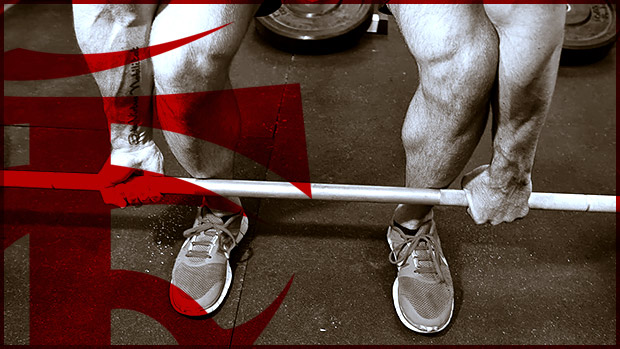No exercise provides as many simultaneous benefits as the deadlift. And perhaps more importantly, the deadlift is a primal display of pure badassery. Pulls are fun as hell, and it's damn important to have fun in the gym.
Already a T Nation+ Member? Log in
You haven’t completed your membership signup
Your T Nation+ membership has expired
Get instant access to this content
Become a T Nation+ member and get immediate access to all of our member-only videos, articles, coaching groups and more.
Click here to learn more about T Nation+Click here to complete the signup processClick here to renew your membership
All those benefits come with a price, however, and that price is paid with your recovery reserves. Because so much load can be lifted, and because of the enormous stresses placed on your entire body, the deadlift requires intelligent recovery management. And the longer you've trained and the stronger you are, the more strategic you'll need to be.
Below I'll show you one such strategic approach, which I've cheekily coined the Badass Deadlift Program. Think of this training strategy as a hypothetical model to stimulate your creative thinking. You don't need to copy this program blindly, but use it as a launching pad to stimulate some personal problem solving.
First, I'll present a bare-bones description of the 3-week program, followed by its benefits. Finally, I'll answer a handful of questions about applying this cycle.
You'll deadlift once every 7 days, cycling between three different methods each week:
Week 1 – Modified Sadiv Deficits
I've slightly modified Rich Sadiv's original brainchild, 12 Minutes of Singles, for my purposes. In short, you'll warm up to roughly 60-65% of your conventional deadlift 1RM and, while standing on a short platform, you'll do 20 singles in 5-7 minutes. More details on this later.
Week 2 – Halting Deadlifts
The halting deadlift involves pulling the bar to a point just below your kneecaps, then back to the floor, then all the way back to a fully standing position, and finally taking it back to the floor – that's one rep.
Think of it as the "1.5 method" applied to deads. Depending on your current strength level, you'll do 1-3 sets of 5 reps.
Week 3 – RM Testing
Week 3 is test week. You'll warm up to one single work set of as many reps as possible (AMRAP). Once you've completed week 3, it's back to week 1 with slightly greater loads. Rinse and repeat.
The bigger and stronger you get, the more physically challenging it becomes to train the deadlift in a linear progression style. By linear progression, I'm talking about performing (for example) 3 sets of 5 every session, attempting to add weight each time. If this style works for you, you're a novice. If it doesn't, you're not.
1 Diversification makes hard work more palatable, and it's easier to recover from.
The stronger you get, the more important variety becomes, but that variety must be intelligently planned. In reality, the best type of variety makes it feel like you're doing something different when you really aren't. For this program, you're really just doing deadlifts every week, but they're three slightly different types of pulls, using three different loading zones.
After you pull your brains out on the test week, for example, it's a relief to know that you'll be doing something reasonably different the following two weeks.
2 Sadiv sets give you 20 opportunities to master the first rep.
Sadiv sets allow the performance of many "first reps" in each workout. Most of the time, rep 1 is the most difficult because it doesn't have the stretch-shortening cycle benefit of the eccentric stretch from the previous rep. (A stretch-shortening cycle is where you take advantage of the energy storage capabilities of a stretched muscle.)
Compared to a more conventional set-rep format where you might have the opportunity to do 3-5 first reps, Sadiv sets give you 20 opportunities to master the first rep. The result? Rapid improvements in the consistency, skill, and economy of your first rep.
3 Halting deadlifts build the starting portion of a pull.
Halting deadlifts target another component of the deadlift that often proves tricky – the starting portion of the pull. Common errors run the gamut from not understanding how to get tight on one end, to trying to "jerk" the bar from the floor on the other.
From a great start all things are possible. Halting deads give you the benefit of 2 starts with each rep. Because the first portion of the rep (where you only pull the bar to the bottom of your knees) is so short, you'll learn to avoid jerking the bar. And because you'll be spending so much time at or near the start position, you'll learn how to be more comfortable and economical during the early portion of the pull.
Note: If your weakness is different from the one I'm addressing here, feel free to modify this cycle with different exercises that more directly target your shortcomings. For example, if your lockout needs work, you might use block pulls or band-resisted pulls to accentuate that portion of your pull.
4 Different progression metrics keep you motivated.
When you always do conventional pull (or any type for that matter), you have only a single progression metric with which to assess your progress. Week after week, either you're able to add weight and/or reps, or you're not. If, on the other hand, you conscientiously train, monitor, and track three different pull variants, you've now got three times the opportunities for new PR's, and a PR in one will bleed over to PR's in the others.

Now let's pop open the hood and have a look at the specifics.
On your very first day of running this cycle, warm up to a weight that's between 60 and 65 percent of your conventional deadlift 1RM. If you don't know this metric, either use one of the many formulas available to convert your current 5-10 rep max to a hypothetical 1RM, or simply use a weight you can get 10 reps with. If you're still in doubt, err on the lighter side – there'll be plenty of time to increase the load later.
Do the Sadiv method using a slight deficit, meaning you'll stand on a low platform, between 2.5 and 5 percent of your height.

Deficit pulls increase the bar's range of motion and strengthen the initial stage of the pull, so when you return to your normal ROM (range of motion) on your next pulling session, it'll feel like a vacation.
When it comes to the amount of deficit to use, err on the side of "less is better." At 6'2", I use a 3.5" platform, but I'm experienced and I've got long hamstrings, which allow me to maintain a neutral lumbar posture, even with this much of a deficit. If you've never done deficit pulls or you have difficultly keeping the arch in your low back while pulling or squatting, opt for a lower platform initially.
Once you've finished your warm-ups, start a stopwatch and start knocking off your 20 singles. There's no rule about pace, but it's imperative that you disengage from the bar and return to a standing position between reps. Your goal is to finish all 20 reps in 5 minutes or less (roughly one rep every 15 seconds), and if you accomplish this, you've earned the right to increase your load by 3 percent the following week.
If, however, it took you more than 7 minutes to get all 20 reps finished, use the same weight the following week.
As you perform these reps, focus on perfection of movement: a consistent and accurate foot and hand placement, an efficient, tight pre-lift crouch, and a smooth and fast lift, ending in an assertive lockout.
This week you'll be working on perfecting the first half of the pull. Warm up to about 65-70 percent of your conventional 1RM, or just use 10-20 more pounds than you used during Sadiv sets the previous week.
Each rep consists of pulling the bar smoothly but aggressively to just below your kneecaps, lowering it back to the platform, pulling a full-ROM rep all the way to a standing position, and then lowering the bar back down to the floor.
In other words, these sets of 5 are really sets of 10 in disguise. So as you're figuring out what weight to use, consider that if you can't deadlift it for 10 normal reps, you'll have no shot at getting 5 halting reps.
Do 1 to 3 sets of 5, depending on your current strength levels. If your conventional deadlift max is lower than 400 pounds, do 3 sets. Between 400-500, 2 sets. Over 500? 1 set.
As you perform these halting reps, focus on developing an aggressive but smooth start – no jerking or yanking. When viewed from the side, your torso angle shouldn't change until the bar is higher than your knees. If your tail rises faster than your shoulders (a sign of weak legs), cue yourself to do the opposite: try to make your shoulders rise faster than your hips. Things should straighten out.
Another critical technique check is to ensure that there's no body movement before the plates break from the floor – you and your barbell should move simultaneously, like a single unit.
After two weeks of relatively light technique training, you should be fresh and anxious to go heavy. How heavy depends on lots of factors, including your experience level and current training goal. But you're not going for a 1-rep max here, but rather a "rep PR" – hit a certain number of reps using the heaviest weight you can.
- If you're training for general fitness/bodycomp or you're on the inexperienced side with the deadlift, shoot for a single max set of between 8-10 reps.
- If you're more experienced and focused on maximum strength, aim for a lower rep bracket, 3-5.
Regardless of what approach you use initially, after 4-6 continuous weeks of using the same rep target, it'll be wise to switch to a different bracket to combat adaptive resistance – your body's inevitable reduced response to a repeated training stimulus.

Only one set for the first two weeks? Is that enough work?
First, let's wait until test week to make that determination. If you've hit a new rep PR, it was enough. If you haven't, either you did too little or too much. And, needless to say, if you only used one working set during the previous weeks, you already have your answer.
Keep in mind that training is a process, not a single event. Whenever you start a new cycle, keep your loads and volumes low enough to ensure that they're definitely not excessive, and then build from there. Be patient and focus on the long-term reward.
What about training the rest of my body?
I recommend it! Continue training your upper body any way you like. I'd suggest training each upper-body muscle group 2-3 times per week. Then, if you typically pull once a week, simply use this cycle for your pulls, and then continue with any other lower-body accessory movements you deem useful.
If you typically pull twice a week, remove deads from that second session and replace them with an alternative lower-body movement of your choice. Finally, if you typically pull 3 times a week, stop doing that... unless your max is under 200 pounds.
What if I pull sumo?
While this cycle was designed for conventional deadlifters, you can still use the underlying strategies to improve your sumo. Simply use the Sadiv method using your sumo pull (but no deficit) on week 1, and then choose a targeted deadlift variant designed to address your most significant weakness on week 2. If your lockout needs work, you might use sumo block pulls or sumo band-resisted pulls to accentuate that portion your pull.
Finally, on week 3, commence with testing using the sumo technique.





